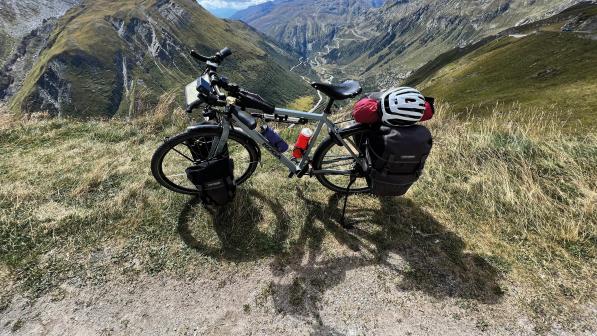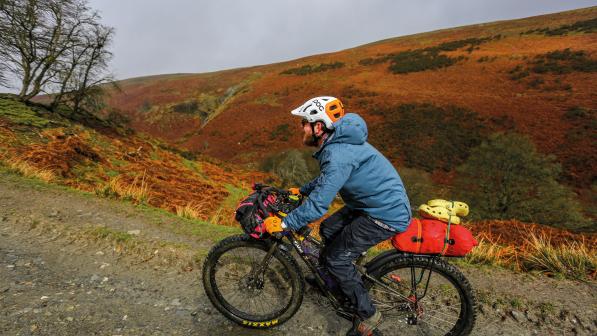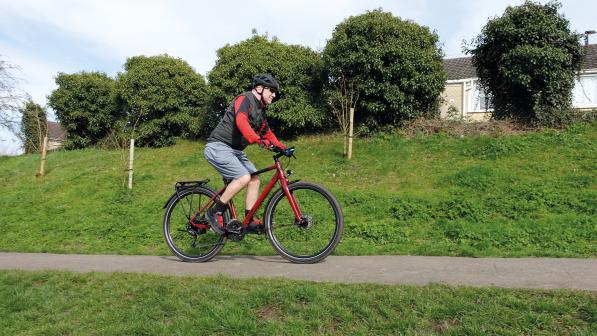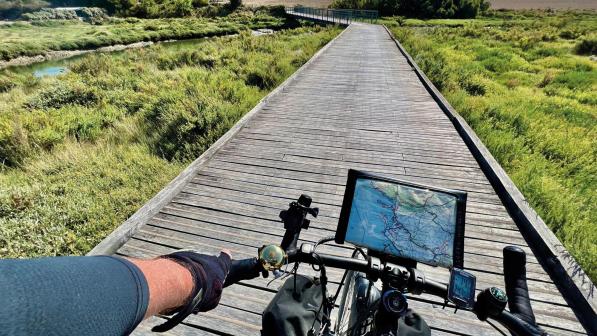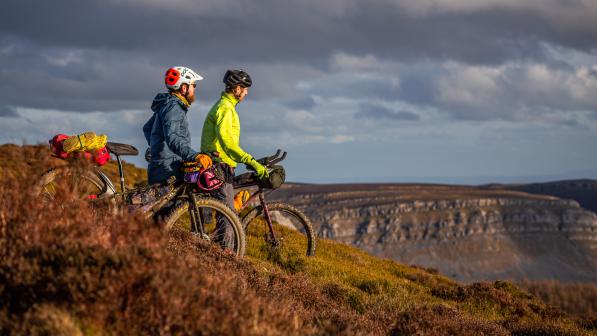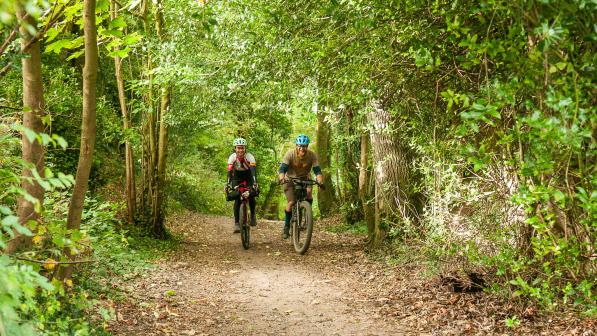Great rides: Wayfarer’s wheel tracks

“Well at least it’s not snowing,” I panted to Robby as the rain came down. The wind whipped his reply away before my ears could capture it, carrying it back down the valley to the faraway hamlet of Llanarmon Dyffryn Ceiriog where we’d started earlier that morning.
The track we followed was more suited to salmon heading to their spawning grounds than bikes. A shallow river flowed where the gradient gave it urgency. Elsewhere, small lagoons were forming where the route flattened out. To put it mildly, it was wet.
The conditions were not surprising for Wales on the final weekend of March. They were also far more favourable than those faced by Wayfarer, the Choirmaster and the Old Gentleman on the same weekend 104 years ago.
Back then, these three men on fixed-wheel bicycles faced deep drifts of snow and a white landscape devoid of feature. They walked much of the ups and downs of the Berwyn Mountains on their way from the West Arms.

The original ride
The account of Wayfarer’s ride was first published in Cycling (now Cycling Weekly) in May 1919, under the title ‘Over the Top’. It’s an uplifting article of adversity and friendship, told with a deft comic touch that evokes the whimsy of Jerome K Jerome’s cycling adventures in Three Men on the Bummel.
Wayfarer’s ride was more dramatic than Jerome’s, not just because of the difference between summer in Germany’s Black Forest and the wintry mountains of North Wales but also for the ride’s proximity to the end of the Great War. The Armistice was declared just five months prior. The headline of ‘Over the Top’ will have had a very different meaning for most.
Wayfarer served and, though injured, survived the Great War. Reading the way he reclaims this phrase from the horrors of war, so that it becomes synonymous with the pursuit of wonder in the natural world by venturing into the wild on two wheels or two feet, goes a long way to explaining his enduring popularity with the cycling community of the time.
The article is life affirming, accessible and inspirational. Ever since reading it, I too have wanted to venture ‘over the top’ on the final weekend of March as the clocks spring forward. I’ve been harping on about doing this ride ever since I missed out on the opportunity to join Jack Thurston’s centennial ride in March 2019.
First two years of lockdowns blocked my attempts, and then an imminent addition to the family. But March 2023 I had my chance.

Right as rain
The previous night in the Wayfarer room in the West Arms in Llanarmon Dyffryn Ceiriog, we’d pored over the map, tracing the route I’d put together based on Wayfarer’s account of his ride from the same pub to Llandegla. Outside heavy rain fell. We were glad to have a real roof rather than canvas for the night.
The morning greeted us with rainbows, coffee and a hearty breakfast. Outside the daffodils bloomed. The occasional rain squall did nothing to dent our enthusiasm as we assembled our machines.
Passing an ominous sign – “Road closed ahead” – we left the village and began to climb. It started as tarmac, which gradually grew more battered by heavy agriculture equipment, until it became that most varied of things: a British farm track.
As we left civilisation behind and ascended the moor above the River Ceiriog, the rain, a soft caress at first, grew wilder. Hoods came up but our faces broke into wide grins.
Wayfarer said he was “a stickler for observing the feast days and holidays”, by which he meant the start and end of the cycling seasons. His ride over the top marked the end of the off-season. As we followed in his wheel tracks, I think we all began to see the appeal.
After a winter of wet weather, the conditions we rode through would normally have seen us remain indoors. But we were marking the shifting of the seasons and, as Keir reflected: “A bit of rain isn’t a reason not to ride.”

What bike for the Wayfarer Pass?
With modern gearing and good fitness, the east side to the memorial is rideable for the most part. By the old shooting hut marked on the OS map, however, we encountered a quagmire that halted us – and also a posse of petrol-powered bikes.
Flurries of mud rooster-tailed several metres high as they tried to coax their heavy machines through axle-deep filth. With our lighter steeds, we simply waded on to terra firma and took the opportunity to ride once more.
As the final push for the top began, the surface became looser. Picking a line and maintaining momentum became harder. Occasional stops gave us opportunities to look back. If I began to pause more often than my companions, I blame the view of the opening valley through the mizzle as much as my lacklustre legs.
It was on one such pause that I turned to hear the clatter and jangle of a bike coming down rather than up. Guiding his gravel bike down, nimble as an ibex, came Ross Adams, another colleague. Living just over the hill, he had decided to join our adventures for the day. Wearing shorts and riding on the drops, you’d have thought he was on a different day out from the rest of us, riding our fatter-tyred all-terrain bikes in trousers.
A bunch of withered daffodils rested beneath the time-battered memorial to Wayfarer, ‘Lover of Wales’. Close by a lamb bleated for its absent mother. The wind and rain swept in.
In such company, however, this bleak-sounding setting was anything but. The conditions, the landscape and company rekindled our appetite for the outdoors. Nothing could have dented our enthusiasm for the ride ahead.

Night on the hills
After briefly paying our respects to the ride’s founder, we headed down smoother, if steeper, tracks towards the road to Cynwyd. Reaching the bottom, our overheated rotors squealed as we halted at the metalled road and the first cars we’d seen all day.
Riding with a local always has benefits. Ross led us along an old railway trail, which once would have taken passengers to Barmouth and its famous bridge. Now this railway, resurrected by volunteers, ends in Corwen, where we were stopping for lunch. On the wall of what is now Ross’s barber’s shop there’s a CTC Repairer’s sign.
Filled with pasties, we then climbed trails that traversed Llantysilio Mountain. This grassy bridleway seemed little travelled, which may have been due to the frequent locked gates that would put off all but the most determined.
By now the sun had chased away our waterproofs. Clear skies rewarded the morning’s efforts with views towards Llandegla Forest. We bade farewell to Ross at the Ponderosa Café, after he passed on further pearls of local wisdom for the following day’s riding.
In the golden evening, we wild camped on the summit of Cyrn-y-Brain. Feasting on porcini risotto, with a wee nip of Keir’s scotch to keep away the chill, we hit the sack as the night’s stars were lost in the clouds.
The following morning bore echoes of the previous. We brewed tea under my tent’s fly, breakfasting in the dry on overnight oats. Visibility was almost zero. With a quick look at the map and compass, we headed east down a likely looking track, which we hoped would lead to the World’s End.
Battling mire on the descent was easier than going up but was still hard work. It took us nearly an hour to ride two kilometres – and 200 metres downhill – to the tarmac. Once there, the sun came out again. We swooped down the quiet roads beneath Eglwyseg Mountain.
A cliff face like giant dentures stretched in a southerly direction towards Llangollen, taking great chomps out of the countryside, leaving only farms and smallholdings in its shadow. The traffic was light, with only walkers and Sunday club runs zipping past with smiles and waves. With the gradient with us, we soon arrived in Berwyn.

Journey’s end
Pausing briefly for a cuppa and to charge water bottles in the time capsule of Berwyn train station’s café, where Turkish Delight, Salt ’n’ Shake crisps and other reminders of childhood were available, we then began the quiet road over the hill and down the steep descent to the village of Glyn Ceiriog.
The last miles to the West Arms rolled by. Here and there we passed more emblems of the past: post boxes commemorating the king – George, not Charles. More banks of daffodils filled the verges with colour.
Rounding a final bend in the road, we returned to Llanarmon Dyffryn Ceiriog to complete a journey that had been short in distance but rich in experience. The off-season’s end had been marked in a way that Wayfarer would have approved.
